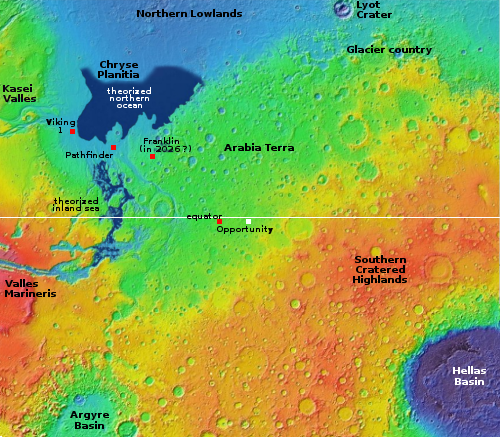Crazy badlands in the equatorial region of Mars
Cool image time! The photo to the right, rotated and cropped to post here, was taken on June 17, 2022 by the high resolution camera on Mars Reconnaissance Orbiter (MRO). The section highlighted is at full resolution, in order to make clear the absolutely crazy and complex terrain seen in the full image.
This terrain is not glacial, as the location is only about 1 degree south of the Martian equator. There might have been surface or near surface ice here once in the past, but there is none now.
Could we be looking at some form of lava flow? This is possible, because a close look at the context map at the image link suggests this region has been partly covered by some material, obscuring some craters to the east and west. However, there is no visible evidence anywhere in this region of a volcanic vent or caldera. If this covering material was volcanic it is very unclear where it came from.
The overview map below does not really provide any answers, but at least gives the context.

The white dot at the center of the map marks the location of these badlands, about 300 miles east of where the rover Opportunity roamed from 2004 to 2018. This area of Arabia Terra is dubbed Meridiani Planum, with a geology that suggests water was once present in some form.
My guess is that we are looking at the Martian equivalent of what Hawaiians dub as ʻaʻā (pronounced ‘ah ah’) lava, rough, sharp, and rocky lava that is very difficult to travel over. On Earth the clumps can be mere inches or feet across. In this photo they appear to be much larger, tens to hundreds of feet in diameter, though up close we might see the same rough features at a smaller scale.
Regardless of the geological origin, this terrain looks to be some of the most difficult on Mars to cross. In fact, I suspect exploring it will never be easy, even with helicopters.
On Christmas Eve 1968 three Americans became the first humans to visit another world. What they did to celebrate was unexpected and profound, and will be remembered throughout all human history. Genesis: the Story of Apollo 8, Robert Zimmerman's classic history of humanity's first journey to another world, tells that story, and it is now available as both an ebook and an audiobook, both with a foreword by Valerie Anders and a new introduction by Robert Zimmerman.
The print edition can be purchased at Amazon or from any other book seller. If you want an autographed copy the price is $60 for the hardback and $45 for the paperback, plus $8 shipping for each. Go here for purchasing details. The ebook is available everywhere for $5.99 (before discount) at amazon, or direct from my ebook publisher, ebookit. If you buy it from ebookit you don't support the big tech companies and the author gets a bigger cut much sooner.
The audiobook is also available at all these vendors, and is also free with a 30-day trial membership to Audible.
"Not simply about one mission, [Genesis] is also the history of America's quest for the moon... Zimmerman has done a masterful job of tying disparate events together into a solid account of one of America's greatest human triumphs."--San Antonio Express-News
Cool image time! The photo to the right, rotated and cropped to post here, was taken on June 17, 2022 by the high resolution camera on Mars Reconnaissance Orbiter (MRO). The section highlighted is at full resolution, in order to make clear the absolutely crazy and complex terrain seen in the full image.
This terrain is not glacial, as the location is only about 1 degree south of the Martian equator. There might have been surface or near surface ice here once in the past, but there is none now.
Could we be looking at some form of lava flow? This is possible, because a close look at the context map at the image link suggests this region has been partly covered by some material, obscuring some craters to the east and west. However, there is no visible evidence anywhere in this region of a volcanic vent or caldera. If this covering material was volcanic it is very unclear where it came from.
The overview map below does not really provide any answers, but at least gives the context.

The white dot at the center of the map marks the location of these badlands, about 300 miles east of where the rover Opportunity roamed from 2004 to 2018. This area of Arabia Terra is dubbed Meridiani Planum, with a geology that suggests water was once present in some form.
My guess is that we are looking at the Martian equivalent of what Hawaiians dub as ʻaʻā (pronounced ‘ah ah’) lava, rough, sharp, and rocky lava that is very difficult to travel over. On Earth the clumps can be mere inches or feet across. In this photo they appear to be much larger, tens to hundreds of feet in diameter, though up close we might see the same rough features at a smaller scale.
Regardless of the geological origin, this terrain looks to be some of the most difficult on Mars to cross. In fact, I suspect exploring it will never be easy, even with helicopters.
On Christmas Eve 1968 three Americans became the first humans to visit another world. What they did to celebrate was unexpected and profound, and will be remembered throughout all human history. Genesis: the Story of Apollo 8, Robert Zimmerman's classic history of humanity's first journey to another world, tells that story, and it is now available as both an ebook and an audiobook, both with a foreword by Valerie Anders and a new introduction by Robert Zimmerman.
The print edition can be purchased at Amazon or from any other book seller. If you want an autographed copy the price is $60 for the hardback and $45 for the paperback, plus $8 shipping for each. Go here for purchasing details. The ebook is available everywhere for $5.99 (before discount) at amazon, or direct from my ebook publisher, ebookit. If you buy it from ebookit you don't support the big tech companies and the author gets a bigger cut much sooner.
The audiobook is also available at all these vendors, and is also free with a 30-day trial membership to Audible.
"Not simply about one mission, [Genesis] is also the history of America's quest for the moon... Zimmerman has done a masterful job of tying disparate events together into a solid account of one of America's greatest human triumphs."--San Antonio Express-News



Just to come over all Hoagland… But that large crater at the top looks like it has a stairway leading into the plant from little shop of horrors….. Finally! Proof of life on Mars!!
But seriously…. ( And I mean the crater at the top of the full photo ), that intrigues me… I know the parallel (ish ) lines are believed to be dunes rather than glass tubes, but they do appear to be descending into the abyss… And it looks like there is sold cratered ground either side of said abyss….
Bob, or anyone else used to analysing Mars images.. I would be very grateful for any possible explanation of what the heck is going on here…
Lee S: Those parallel lines are ripple dunes, a very common feature on Mars. However, the floor of the crater is very interesting, in that it appears something over time cleared material from its center (where the dunes are), leaving two rough terraces on either side.
This could be left over from when there were glaciers here. Or maybe the rough terraces are lava that did not fill the entire crater.
Lee S: Thank you for pointing out this feature. That is a seriously ‘What The . . .’ formation. But, it is very cold, and a relatively shallow gravity well. Many graduate degrees out of this one.
Lee–
–going way tangential here….
“Under the Great Lakes”
NatGeo
https://youtu.be/VAo4qvP6o2E
45:18